
Color and fragrance explode at the U of A Devonian Botanic Garden
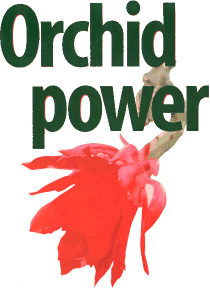 Epiphyllum hybrid
Epiphyllum hybrid

Color and fragrance explode at the U of A Devonian Botanic Garden |
 Epiphyllum hybrid
Epiphyllum hybrid
|
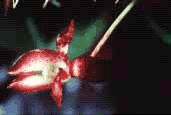
Encyclia cochleata |
As you open the door to the warmth of the humid greenhouse, you're lured by vibrant color, shapes, textures and the enticing fragrance of orchids.
The new Orchid House at the University of Alberta Devonian Botanic Garden (DBG) contains more than 500 different kinds of tropical orchids -- species, hybrids, and varieties. "The collection is unique because no other facility in Edmonton has an open display to the public," says Dr. Dale Vitt, professor of biological sciences and director of the DBG.
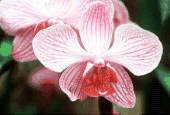
Phalaenopsis Cassandra X Geralda 'Rainbow Peace' |
Orchids -- from the plant family Orchidaceae -- have die-hard fans. There are orchid festivals and fairs, websites, and trade shows. They're even left in wills from time to time. The allure lies in their diversity. There are at least 30,000 wild species and more than 200,000 hybrids worldwide. "People are attracted to the enormous variety," says Sean Abbott, Ph.D. student studying fungi at the Devonian. "They are dramatic because their colors are vibrant, their fragrance intoxicating, and their blooms can last anywhere from six to eight weeks. Some plants can produce more than 600 blooms, thereby increasing their appeal."
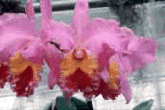
Cattleya Irene Holguin 'Brown Eyes' |
Orchids exhibit amazingly different shapes, forms, and growth habits. Some produce blossoms no larger than a mosquito; others as large as a dinner plate. Most require no soil. They come in four types, according to where they grow. Most are classified as epiphytes, or air plants, which grow primarily on trees. Lithophytes cling to rock surfaces. Saprophytes grow in decaying vegetation on the forest floor. Finally, there are terrestrials, which anchor themselves in soil or sand. As most orchids are epiphytes, they can be grown in tree bark (fir or redwood), crumbled charcoal, pebbles, on tree-fern or cork plaques.
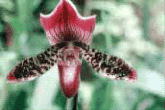
Paphiopedilum Red Glory X Grand Master |
Not all orchids are tropical. They are found almost anywhere including the barren Arctic tundra. They're tough and resilient, but grown from seed can take anywhere between five and 15 years to produce the first bloom, which increases their value.
A few orchid fragrances defy description, while others mimic familiar aromas -- raspberry, coconut, lilacs, and citrus. Others have no scent, but rely on shape and color to attract insects or birds for pollination. There's currently a strong hint of coconut in the air at the Devonian, thanks to a Maxillaria tenuifolia.
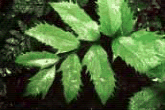
|
Orchids are a must for human mating rituals -- or at least significant occasions like graduations. But they induce a pretty spicy mating ritual of their own. While most flowers have separate male and female organs -- the stamen and pistils -- orchids possess a combination of the two and form a single structure called the column. The bloom is cleverly disguised to look like the female anatomy of a wasp or bee, which entices male wasps and bees in. Once inside, the no doubt disappointed insect leaves, taking a sticky pollination sac with him. When the male is enticed into another orchid, (of the same variety) it deposits the sac in the reproductive organs of that plant.
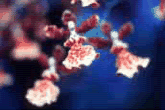
Odontocidium Susan Kaufman |
For orchid fanciers, a simpler route is often artificial pollination, done by removing the pollinia with a toothpick and placing it on the stigmatic surface of the orchid. "This is actually a very simple process," says Abbott, although the seeds are tiny.
"They produce a seed capsule, a pod-like structure, that can contain up to one million seeds no bigger than a speck of dust."
All orchids at the house were donated -- with the largest collection from Howard Northey of Red Deer. A donor wall at the Devonian displays all contributors.
In addition to orchids, the greenhouse contains more than 100 types of other epiphytic plants including a collection of bromeliads -- another air plant (epiphyte) adapted for dry conditions -- and a collection of epiphytic cacti.
![[Folio]](http://www.ualberta.ca/~publicas/folio/gif/small/folio.gif)
Folio front page |
![[Office of Public Affairs]](http://www.ualberta.ca/~publicas/gif/small/opahome.gif)
Office of Public Affairs |
![[University of Alberta]](http://www.ualberta.ca/~publicas/gif/small/uahome.gif)
University of Alberta |